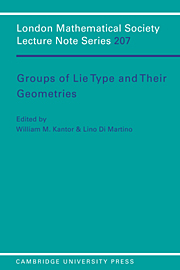Book contents
- Frontmatter
- Contents
- Preface
- List of talks
- List of participants
- Representations of groups on finite simplicial complexes
- Coxeter groups and matroids
- Finite groups and geometries: A view on the present state and on the future
- Groups acting simply transitively on the vertices of a building of type Ãn
- Finite simple subgroups of semisimple complex Lie groups – a survey
- Flag-transitive extensions of buildings of type G2 and C3*
- Disconnected linear groups and restrictions of representations
- Products of conjugacy classes in algebraic groups and generators of dense subgroups
- Monodromy groups of polynomials
- Subgroups of exceptional algebraic groups
- The geometry of traces in Ree octagons
- Small rank exceptional Hurwitz groups
- The direct sum problem for chamber systems
- Embeddings and hyperplanes of Lie incidence geometries
- Intermediate subgroups in Chevalley groups
- On a certain class of Frattini extensions of finite Chevalley groups
- Economical generating sets for finite simple groups
Subgroups of exceptional algebraic groups
Published online by Cambridge University Press: 06 January 2010
- Frontmatter
- Contents
- Preface
- List of talks
- List of participants
- Representations of groups on finite simplicial complexes
- Coxeter groups and matroids
- Finite groups and geometries: A view on the present state and on the future
- Groups acting simply transitively on the vertices of a building of type Ãn
- Finite simple subgroups of semisimple complex Lie groups – a survey
- Flag-transitive extensions of buildings of type G2 and C3*
- Disconnected linear groups and restrictions of representations
- Products of conjugacy classes in algebraic groups and generators of dense subgroups
- Monodromy groups of polynomials
- Subgroups of exceptional algebraic groups
- The geometry of traces in Ree octagons
- Small rank exceptional Hurwitz groups
- The direct sum problem for chamber systems
- Embeddings and hyperplanes of Lie incidence geometries
- Intermediate subgroups in Chevalley groups
- On a certain class of Frattini extensions of finite Chevalley groups
- Economical generating sets for finite simple groups
Summary
Throughout this paper, let G be a simple algebraic group of exceptional type over an algebraically closed field K of characteristic p. The maximal closed connected subgroups of these groups were determined in [Se], subject to some mild restrictions on the characteristic p. In this article we describe some results from [LS2] concerning arbitrary closed connected reductive subgroups of G, again assuming mild characteristic restrictions (in particular, p = 0 or p > 7 covers all the restrictions).
Before giving detailed statements, we give a general description of the results. Theorems 5 and 6 below determine the embeddings of arbitrary closed connected semisimple subgroups in G: if X is such a subgroup, then X is embedded in an explicit way in a “subsystem subgroup” of G – that is, a semisimple subgroup which is normalized by a maximal torus of G. Subsystem subgroups are constructed naturally from subsystems of the root system of G; this therefore determines the embedding of X in G. As a consequence, when p = 0 there are only finitely many conjugacy classes of such subgroups X, whereas there are infinitely many when p > 0.
The proofs are based on Theorem 1, which states that if the reductive subgroup X lies in a parabolic subgroup P = QL of G, with unipotent radical Q and Levi subgroup L, then some conjugate of X lies in L. This result can also be used to prove that CG(X) is always reductive (Theorem 2).
- Type
- Chapter
- Information
- Groups of Lie Type and their Geometries , pp. 151 - 156Publisher: Cambridge University PressPrint publication year: 1995



